Curious about Actual OMG OCUP (OMG-OCUP2-ADV300) Exam Questions?
Here are sample OMG Certified UML Professional 2 (OCUP 2) - Advanced Level (OMG-OCUP2-ADV300) Exam questions from real exam. You can get more OMG OCUP (OMG-OCUP2-ADV300) Exam premium practice questions at TestInsights.
Choose the correct answer:
Consider the following sequence diagram GO:
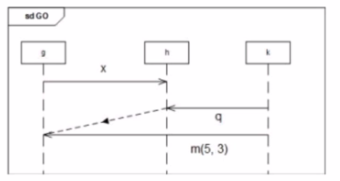
What is always true according to the diagram?
Correct : A
In the sequence diagram 'GO', the event 'h receives x' is depicted before 'k sends q', as indicated by the solid arrow from 'g' to 'h' labeled 'x' and the dashed arrow from 'k' labeled 'q'. Since messages are processed in the order they are depicted from top to bottom, 'h' must receive 'x' before 'k' can send 'q'.
The other options (B, C, and D) cannot be determined to be always true based on the information provided in the diagram alone. Especially with asynchronous messages, the send event may occur before the corresponding receive event, and the diagram does not contain sufficient information about timing constraints or message processing durations to ascertain the exact ordering of these events.
Reference include:
UML 2.5 Specification (formal/2017-12-05), specifically the sections regarding message sends and receives, lifelines, and the semantics of sequence diagrams.
Introduction to UML 2 Sequence Diagrams by Scott W. Ambler, which provides insights into the interpretation of sequence diagrams and the flow of messages.
Start a Discussions
Choose the correct answer:
Consider the following sequence diagram:
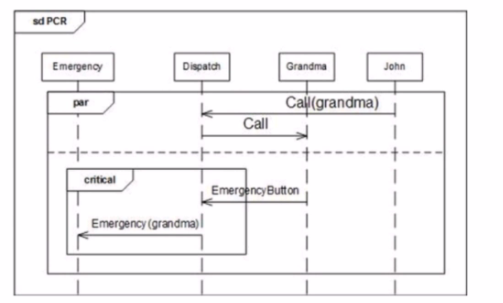
What does "critical" refer to?
Correct : C
In UML 2, a ''critical'' section in a sequence diagram, like the one depicted, refers to a period where certain interactions are protected so that they can be executed without interruption or interference from other interactions (events). This is akin to a critical section in multi-threading where certain threads have exclusive access to resources or operations for a period of time. The correct answer is option C because it aligns with this definition: during the ''critical'' section on the sequence diagram, no other events may interfere between its events.
Start a Discussions
Choose the correct answer:
Consider the following diagrams:
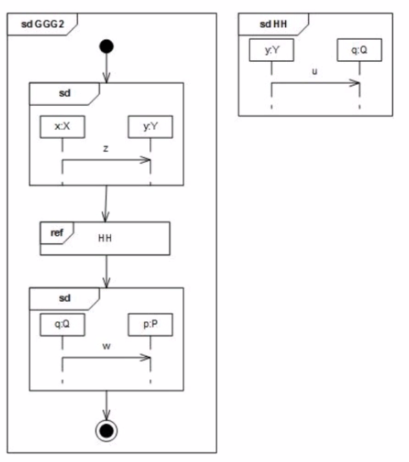
When this behavior is executed, which event will occur last?
Correct : D
The UML sequence diagrams provided do not offer enough information to definitively determine the order of event occurrences. Sequence diagrams are used to show how objects interact in a given scenario, particularly the order of messages exchanged between objects. However, without a clear indication of the sequence or additional context, it's impossible to ascertain which event occurs last.
In UML 2.x, sequence diagrams can be interconnected, but the execution order across separate diagrams is not inherently defined unless explicitly specified. Therefore, based on the information given, the answer is D, as we cannot uniquely determine the last event occurrence without additional details.
OMG Unified Modeling Language (OMG UML), Infrastructure Version 2.5
UML 2.x specifications and sequence diagram notations
Start a Discussions
Choose the correct answer:
Consider the following UML diagram fragments:
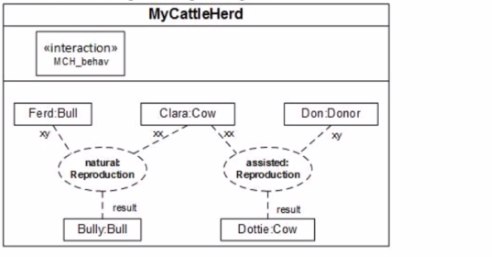
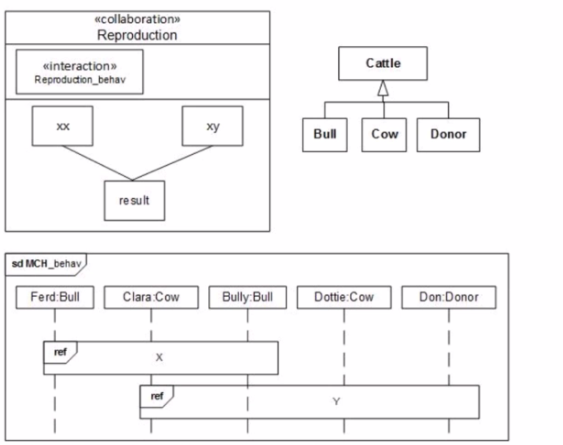
The letters X and Y are placeholders. What should X and Y be?
Correct : E
The question is about identifying the correct placeholders X and Y in a UML diagram fragment related to cattle reproduction behavior. The correct answer is option E, where X is ''natural::Reproduction_behav'' and Y is ''assisted::Reproduction_behav''. In UML, the ''::'' notation is used to indicate a namespace or a package. In this context, it separates the types of reproduction behaviors (natural and assisted) from the behavior itself (Reproduction_behav). This naming convention aligns with UML naming standards for clarity and specificity.
Start a Discussions
Choose the correct answer:
What is correct about the modeling of individual things with UML?
Correct : D
In UML, modeling individual things (such as instances) involves making statements about them. Here are the details for each option:
A . A UML Model can contain individual things (e.g. Instances) UML does not prescribe the level of detail to be used in the description.
This statement is partially correct. UML models can indeed contain individual things (instances), but the level of detail is not explicitly prescribed by UML. However, the statement does not cover the possibility of incomplete or imprecise information.
B . A UML Model can contain statements about individual things If a thing is an instance of a Classifier, these statements must be consistent (all mandatory Properties must be defined, all Constraints must be satisfied).
While it is true that a UML model can contain statements about individual things (instances), the requirement for consistency (mandatory properties and constraints) is not explicitly mentioned in UML. Therefore, this option is not entirely accurate.
C . A UML Model can contain statements about individual things These statements can be incomplete, imprecise, and abstract, but not wrong.
This statement is also partially correct. UML allows for incomplete, imprecise, and abstract statements about individual things. However, it does not guarantee that these statements cannot be wrong.
D . A UML Model can contain statements about individual things. These statements can be incomplete, imprecise, abstract, may turn out to be wrong, or even be asserted as counterfactual.
This option provides a more accurate representation. UML allows for statements about individual things that can be incomplete, imprecise, abstract, and even potentially incorrect. It acknowledges the uncertainty and variability in modeling individual things.
E . A UML Model can only contain statements about sets of individual things (e.g. Classifiers).
This statement is incorrect. UML models can contain statements about both individual things (instances) and sets of things (classifiers).
UML 2.5.1 Specification
While the UML specification does not explicitly state the options, it provides the foundation for UML modeling principles and allows for flexibility in expressing statements about individual things.
Remember that UML is a modeling language, and its primary purpose is to capture and communicate information about systems and their components. The level of detail, precision, and correctness can vary based on the modeling context and the specific use case. Therefore, option D best reflects the UML approach to modeling individual things.
Please note that the information provided here is based on UML 2.5.1, and it's essential to consult the official UML specification for the most accurate and up-to-date details.
Start a Discussions
Total 90 questions